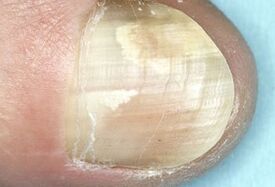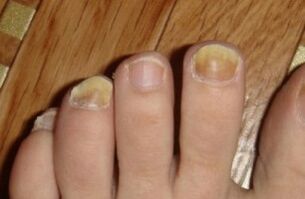
Nail plate fungi on the fingers (onikomycosis of the feet) is an infectious disease manifested in damage to nails from dermatomycetes, mold or fungi similar to yeast.According to statistics, the prevalence of this disease in the population reaches 10%.
The risk of contraction of foot onycomycosis depends directly on the social and climatic conditions of a person's place of residence, gender, age, profession and presence or lack of other diseases.
One way or another, due to the ascent and its high ability to significantly exacerbate the quality of the patient's daily life, this pathology requires timely detection and competent, comprehensive treatment.
Symptoms of fungi of the legs
Depending on the symptomatic manifestations, there are three types of onycomycosis of the foot:
- hypertrophic;
- normotrophic;
- atrophic.
The hypertrophic damage to the nails is characterized by visible thickening and deformation of the nail plates, loss of brightness and the appearance of a type of "erosion" on their edges.The clinical photography of the disease can be supplemented by the onset of pain and the development of onycogyphosis (a pathology in which nails take on the appearance of bird claws).
With normotrophic type onycomycosis, yellow or white stripes and spots appear on the nail plates.At the same time, nails maintain their configuration, brightness and thickness.With atrophic onycomycosis, the nail plate is quickly separated from the nail bed, becomes dull and acquires a gray-brown color.The exposed area of the skin becomes covered with loose hyperkeratotic layers.
Clinical signs of foot fungus form the basis of another classification of onycomycosis, used mainly by foreign doctors.Based on this typology, 4 forms of the disease can be distinguished:
- distal (damage to the free skirt of the nail);
- proximal (damage to the rear nail nail);
- side (nail damage from sides);
- Total (damage to the entire nail plate).
The severity of manifestations of onychomycosis should be taken into account when designing a therapeutic program.
Treatment of fungi of the feet

The diagnosis of "foot onycomycosis" is based on the results of a visual medical examination, PCR test, microscopic and cultural studies.Performing the above tests allows us to get a conclusion not only about the presence of a fungus infection, but also for the type of pathogen.
Now a few words on how to cure the fungus in the shortest possible time.The ethotropic treatment program for onycomycosis includes the use of local and systemic medicines.The most effective tools for local fungal treatment on the foot plates are:
- Ointments, gel and antifungal keratolytic creams;
- Specialized plaster for mechanical removal of affected nails;
- Antifungal spray based on ciclopirox, amorolphine or mixture of salicylicism, benzoic, lactic acid and resorcinol.
Nowadays, systemic nail fungal therapy seems to be more important.In recent years, a number of general antimicotic drugs have developed that can increase the effectiveness of onycomycosis treatment by 90%.
Fungus medicine
Lacs are considered with more effective antimicotic spray.The main distinguishing feature of the products is their ability to destroy pathogens in the deep layers of the nail and penetrate the nail bed.Creams and antifungal ointments include products containing terbinafine.Listed products are applied daily to the affected nail plates and gently rubbed until completely absorbed.The duration of treatment for onycomycosis with ointments and creams can vary between 2-6 weeks.The procedure for using antifungal topical agents should first agree with a dermatologist.
The selection of systemic medicines is performed taking into account the severity of the disease and the presence or absence of contraindications for their use in the patient.
Prevention of fungi
The main measures aimed at preventing the development of foot onycomycosis are:
- avoiding mechanical trauma to nail plates;
- Refusing to wear harsh, tight and appropriate shoes;
- careful processing of pedicure tools;
- use of individual shoes when visiting baths, saunas and pools;
- monitoring of the health status of pets, timely treatment of identified pathologies;
- except for the use of toilets, clothing, towels and shoes that belong to other people;
- timely detection and disease treatment;
- Performing activities aimed at strengthening the body's immune forces.
It is important to understand that self-treatment of onycomycosis often not only fails to achieve the expected results, but also significantly complicates the course of the disease.Therefore, before using any folk remedies or remedies for fungi, you must coordinate the treatment program with an experienced dermatologist.























